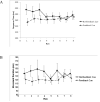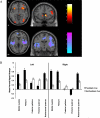Striatal and Pallidal Activation during Reward Modulated Movement Using a Translational Paradigm
- PMID: 26156687
- PMCID: PMC4668805
- DOI: 10.1017/S1355617715000491
Striatal and Pallidal Activation during Reward Modulated Movement Using a Translational Paradigm
Abstract
Human neuroimaging studies of reward processing typically involve tasks that engage decision-making processes in the dorsal striatum or focus upon the ventral striatum's response to feedback expectancy. These studies are often compared to the animal literature; however, some animal studies include both feedback and nonfeedback events that activate the dorsal striatum during feedback expectancy. Differences in task parameters, movement complexity, and motoric effort to attain rewards may partly explain ventral and dorsal striatal response differences across species. We, therefore, used a target capture task during functional neuroimaging that was inspired by a study of single cell modulation in the internal globus pallidus during reward-cued, rotational arm movements in nonhuman primates. In this functional magnetic resonance imaging study, participants used a fiberoptic joystick to make a rotational response to an instruction stimulus that indicated both a target location for a capture movement and whether or not the trial would end with feedback indicating either a small financial gain or a neutral outcome. Portions of the dorsal striatum and pallidum demonstrated greater neural activation to visual cues predicting potential gains relative to cues with no associated outcome. Furthermore, both striatal and pallidal regions displayed a greater response to financial gains relative to neutral outcomes. This reward-dependent modulation of dorsal striatal and pallidal activation in a target-capture task is consistent with findings from reward studies in animals, supporting the use of motorically complex tasks as translational paradigms to investigate the neural substrates of reward expectancy and outcome in humans.
Keywords: Functional magnetic resonance imaging; Pallidum; Reward; Skeletomotor; Striatum; Translational.
Figures





Similar articles
-
Processing of action- but not stimulus-related prediction errors differs between active and observational feedback learning.Neuropsychologia. 2015 Jan;66:75-87. doi: 10.1016/j.neuropsychologia.2014.10.036. Epub 2014 Nov 7. Neuropsychologia. 2015. PMID: 25446969
-
Value and probability coding in a feedback-based learning task utilizing food rewards.J Neurophysiol. 2015 Jan 1;113(1):4-13. doi: 10.1152/jn.00086.2014. Epub 2014 Oct 22. J Neurophysiol. 2015. PMID: 25339705 Free PMC article.
-
Neuronal activity in the striatum and pallidum of primates related to the execution of externally cued reaching movements.Brain Res. 1995 Oct 2;694(1-2):111-27. doi: 10.1016/0006-8993(95)00780-t. Brain Res. 1995. PMID: 8974634
-
Changes in behavior-related neuronal activity in the striatum during learning.Trends Neurosci. 2003 Jun;26(6):321-8. doi: 10.1016/S0166-2236(03)00122-X. Trends Neurosci. 2003. PMID: 12798602 Review.
-
The role of the dorsal striatum in reward and decision-making.J Neurosci. 2007 Aug 1;27(31):8161-5. doi: 10.1523/JNEUROSCI.1554-07.2007. J Neurosci. 2007. PMID: 17670959 Free PMC article. Review.
Cited by
-
Connectivity differences between Gulf War Illness (GWI) phenotypes during a test of attention.PLoS One. 2019 Dec 31;14(12):e0226481. doi: 10.1371/journal.pone.0226481. eCollection 2019. PLoS One. 2019. PMID: 31891592 Free PMC article. Clinical Trial.
-
The human subthalamic nucleus and globus pallidus internus differentially encode reward during action control.Hum Brain Mapp. 2017 Apr;38(4):1952-1964. doi: 10.1002/hbm.23496. Epub 2017 Jan 28. Hum Brain Mapp. 2017. PMID: 28130916 Free PMC article.
-
Multidimensional encoding of movement and contextual variables by rat globus pallidus neurons during a novel environment exposure task.iScience. 2022 Aug 28;25(9):105024. doi: 10.1016/j.isci.2022.105024. eCollection 2022 Sep 16. iScience. 2022. PMID: 36117990 Free PMC article.
-
Neural Mechanisms Underlying Time Perception and Reward Anticipation.Front Hum Neurosci. 2018 Mar 21;12:115. doi: 10.3389/fnhum.2018.00115. eCollection 2018. Front Hum Neurosci. 2018. PMID: 29662447 Free PMC article.
-
Preliminary evidence for human globus pallidus pars interna neurons signaling reward and sensory stimuli.Neuroscience. 2016 Jul 22;328:30-9. doi: 10.1016/j.neuroscience.2016.04.020. Epub 2016 Apr 22. Neuroscience. 2016. PMID: 27109924 Free PMC article.
References
-
- Apicella P, Ljungberg T, Scarnati E, Schultz W. Responses to reward in monkey dorsal and ventral striatum. Experimental Brain Research. 1991;85:491–500. doi: 10.1007/BF00231732. - PubMed

